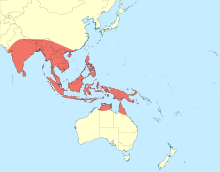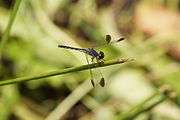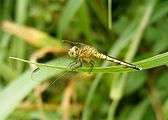Diplacodes nebulosa
Diplacodes nebulosa (the black-tipped percher,[1] black-tipped ground skimmer[3][4] or charcoal-winged percher[5]) is a species of dragonfly in the family Libellulidae. It is a widely distributed species in many Asian countries.[1][6][3][4] and northern Australia.[7][8]
| Black-tipped percher | |
|---|---|
_male.jpg) | |
| Male | |
.jpg) | |
| Female | |
| Scientific classification | |
| Kingdom: | Animalia |
| Phylum: | Arthropoda |
| Class: | Insecta |
| Order: | Odonata |
| Infraorder: | Anisoptera |
| Family: | Libellulidae |
| Genus: | Diplacodes |
| Species: | D. nebulosa |
| Binomial name | |
| Diplacodes nebulosa | |
 | |
| Synonyms | |
|
Libellula nebulosa Fabricius, 1793 | |
Description and habitat
Diplacodes nebulosa is a very small and slender dragonfly.[5] Males have a black abdomen and black wing tips; females are yellow and black, and their wings can be hyaline, or with an orange base, or, like the male, have black tips.[9]
 Male
Male Female
Female_male.%2C_%E0%B4%9A%E0%B5%81%E0%B4%9F%E0%B5%8D%E0%B4%9F%E0%B4%BF%E0%B4%A8%E0%B4%BF%E0%B4%B2%E0%B4%A4%E0%B5%8D%E0%B4%A4%E0%B5%BB._(23900114388).jpg) Sub-adult male
Sub-adult malemating.jpg) Mating pair
Mating pair.jpg) Female wings
Female wings.jpg) Male wings
Male wings
It prefers marshes and heavily weeded ponds.[10][11]
gollark: ¡TJ09!
gollark: It might help a bit.
gollark: Maybe we need a bunch of spriters to post about the ridiculousness?
gollark: Cool translucency.
gollark: Ah. I quite like the existing ones, I guess.
See also
- List of odonates of Sri Lanka
- List of odonates of India
- List of Odonata species of Australia
References
- Dow, R.A. (2017). "Diplacodes nebulosa". IUCN Red List of Threatened Species. 2017: e.T167369A87526935. doi:10.2305/IUCN.UK.2017-1.RLTS.T167369A87526935.en.
- Fabricius, Johann Christian (1793). Entomologia Systematica Emendata et Aucta. Secundum, Classes, Ordines, Genera, Species, adjectis synonimis, locis, observationibus, descriptionibus (in Latin). Hafniae : impensis Christ. Gottl. Proft. p. 379 – via Google Books.
- "Diplacodes nebulosa Fabricius, 1793". India Biodiversity Portal. Retrieved 2017-02-13.
- "Diplacodes nebulosa Fabricius, 1793". Odonata of India, v. 1.00. Indian Foundation for Butterflies. Retrieved 2017-02-13.
- Theischinger, Günther; Hawking, John (2006). The Complete Field Guide to Dragonflies of Australia. Collingwood, Victoria, Australia: CSIRO Publishing. p. 278. ISBN 978 0 64309 073 6.
- Odonata: Catalogue of the Odonata of the World. Tol J. van , 2008-08-01
- Theischinger, Gunther; Endersby, Ian (2009). Identification Guide to the Australian Odonata (PDF). Department of Environment, Climate Change and Water NSW. p. 211. ISBN 978 1 74232 475 3.
- K.A., Subramanian; K.G., Emiliyamma; R., Babu; C., Radhakrishnan; S.S., Talmale (2018). Atlas of Odonata (Insecta) of the Western Ghats, India. Zoological Survey of India. pp. 320–321. ISBN 9788181714954.
- Watson, J.A.L.; Theischinger, G.; Abbey, H.M. (1991). The Australian Dragonflies: A Guide to the Identification, Distributions and Habitats of Australian Odonata. Melbourne: CSIRO. ISBN 0643051368.
- C FC Lt. Fraser (1936). The Fauna of British India, including Ceylon and Burma, Odonata Vol. III. Red Lion Court, Fleet Street, London: Taylor and Francis. pp. 335–336.
- C FC Lt. Fraser (1924). A Survey of the Odonate (Dragonfly) Fauna of Western India and Descriptions of Thirty New Species (PDF). p. 434.
| Wikimedia Commons has media related to Diplacodes nebulosa. |
| Wikispecies has information related to Diplacodes nebulosa |
This article is issued from Wikipedia. The text is licensed under Creative Commons - Attribution - Sharealike. Additional terms may apply for the media files.
